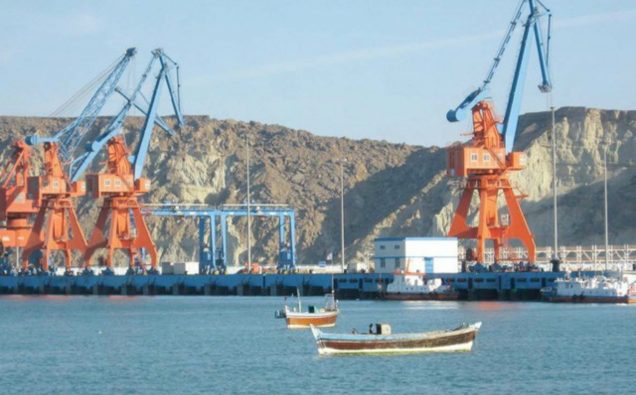
Gwadar deep seaport Photo: Umargondal/Wikimedia Commons
Rebounding agrarian output, stable macroeconomic environment, expanding investments are creating conditions for a higher economic growth momentum for Pakistan with the GDP expected to be 5.5 in 2018, says the latest World Bank forecast.
Released Monday, the World Bank’s June 2017 Global Economic Prospects says Pakistan economic scene will see a 5.2 percent growth in 2017, 5.5 percent in 2018, and 5.8 percent in both 2019 and 2020.
It is after a decade that Pakistani economy is registering such robust growth.
“In Pakistan, agricultural output rebounded following the end of a drought, while the successful completion of an IMF-supported program enhanced macroeconomic conditions and foreign direct investment (FDI),” the Bank said.
The report also notes that “favorable weather and increased cotton prices are supporting agricultural production, and the China-Pakistan Economic Corridor infrastructure project, as well as a stable macroeconomic environment, is contributing to an increase in private investment.”
The forecast comes as the multi-billion dollars CPEC steps up economic activity across a range of sectors including infrastructure, energy, construction projects. Gwadar deep seaport is expected to become a major point of regional trade.
“Pakistan’s growth is expected to increase to 5.2 percent in FY2017 (July 1, 2016 – June 30, 2017) and remain strong over the forecast horizon, reflecting an upturn in private investment, increased energy supply, and improved security. The fiscal deficit should narrow further, as a result of revenue-led fiscal consolidation.”
In South Asia, the Bank notes that inflation has remained benign, hovering below target in Bangladesh, Pakistan, and India. Favorable weather (e.g., India, Pakistan) and lower oil prices have helped keep inflation low, and thereby made possible an accommodative monetary policy.
Despite mixed progress with fiscal consolidation in the region, deficits generally declined
Looking at the region, the Bank says security concerns in some countries (e.g., Afghanistan, Pakistan) could also hold back investment and business confidence. For several countries in the region, increased political or geopolitical tensions could pose major obstacles to economic and financial activity (e.g., Afghanistan, India, Pakistan).
“Upcoming elections in Nepal (between 2017 and 2019), Bangladesh and Pakistan (in 2018), and India (in 2019) could be accompanied by heightened policy uncertainty, and election results could surprise financial markets.”


















